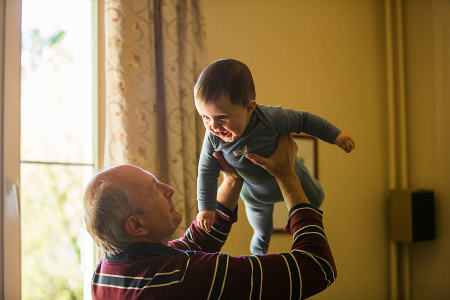We ask you, humbly: don't scroll away.
Hi readers, it seems you use Catholic Online a lot; that's great! It's a little awkward to ask, but we need your help. If you have already donated, we sincerely thank you. We're not salespeople, but we depend on donations averaging $14.76 and fewer than 1% of readers give. If you donate just $5.00, the price of your coffee, Catholic Online School could keep thriving. Thank you.Help Now >
Liturgy: Substituting the 'Lamb of God'
FREE Catholic Classes
And More on Water With Wine
ROME, JULY 14, 2004 (Zenit) - Answered by Father Edward McNamara, professor of liturgy at the Regina Apostolorum Pontifical University.
Q: It is common in my diocese for priests, after the Lamb of God, when the Missal reads "This is the Lamb of God, who takes away the sins of the world ..." to substitute a different (but still true) title or description of Christ -- usually related to the Gospel of the day. For example, "This is Jesus, who today calls us to take up our cross and follow him ..." Is this permitted? -- C.S., Hamilton, New Zealand
A: The short answer to this, and to other similar questions regarding priests altering prescribed texts or composing new ones, is no.
But -- and there is a but -- in some countries and religious congregations, small additions have been made to these prayers with proper authorization from the Holy See.
The general principles involved are those announced in the General Instruction of the Roman Missal, No. 24-26.
No. 24 reminds priests that while some adaptations of the liturgy are possible these "consist for the most part in the choice of certain rites or texts, that is, of the chants, readings, prayers, explanations, and gestures that may respond better to the needs, preparation, and culture of the participants and that are entrusted to the priest celebrant. Nevertheless, the priest must remember that he is the servant of the Sacred Liturgy and that he himself is not permitted, on his own initiative, to add, to remove, or to change anything in the celebration of Mass."
Nos. 25 and 26 refer to other adaptations reserved to the diocesan bishop or to the episcopal conference which often require the definitive ratification of the Holy See.
The recent instruction "Redemptionis Sacramentum" has also weighed in on the topic of unauthorized alterations in No. 31:
"In keeping with the solemn promises that they have made in the rite of Sacred Ordination and renewed each year in the Mass of the Chrism, let Priests celebrate 'devoutly and faithfully the mysteries of Christ for the praise of God and the sanctification of the Christian people, according to the tradition of the Church, especially in the Eucharistic Sacrifice and in the Sacrament of Reconciliation.' They ought not to detract from the profound meaning of their own ministry by corrupting the liturgical celebration either through alteration or omission, or through arbitrary additions. For as St. Ambrose said, 'It is not in herself ... but in us that the Church is injured. Let us take care so that our own failure may not cause injury to the Church.' Let the Church of God not be injured, then, by Priests who have so solemnly dedicated themselves to the ministry. Indeed, under the Bishop's authority let them faithfully seek to prevent others as well from committing this type of distortion."
The document returns to this theme in Nos. 58 and 59: grounding the priest's obligation to respect the liturgical text on the rights of the faithful to a truly Catholic liturgy and on the authentic meaning of liturgy itself.
No. 58 says: "All of Christ's faithful likewise have the right to a celebration of the Eucharist that has been so carefully prepared in all its parts that the word of God is properly and efficaciously proclaimed and explained in it; that the faculty for selecting the liturgical texts and rites is carried out with care according to the norms; and that their faith is duly safeguarded and nourished by the words that are sung in the celebration of the Liturgy."
No. 59 continues: "The reprobated practice by which Priests, Deacons or the faithful here and there alter or vary at will the texts of the Sacred Liturgy that they are charged to pronounce, must cease. For in doing thus, they render the celebration of the Sacred Liturgy unstable, and not infrequently distort the authentic meaning of the Liturgy."
What is important to consider in the case presented is not so much whether the additions involved are theologically correct -- they might well be -- but the fact that an individual priest takes upon himself the role of changing what the Church has established.
By praying in words of his own choosing, and not those chosen by the Church, he, in a sense, betrays the "we" of the presidential prayers which make him the Church's representative before God and obscures the faithful's right to join through his ministry in the prayer of the universal Church.
Such acts are probably often done with the best of intentions and even spring from pastoral motives. But they are objectively acts of theological egotism that transform the common patrimony into an individual's private domain.
As mentioned above, this does not mean that the liturgy is totally untouchable; however, any changes must be made according to the proper procedures.
To take the present examples, some episcopal conferences, above all in Latin America, have, with the Holy See's approval, added the words "Jesus Christ" to the Agnus Dei so as to strengthen the people's faith in the real presence. The priest thus says: "This is the Lamb of God, Jesus Christ, who takes away the sins ..."
Other episcopal conferences, such as the Italian, have composed alternative opening prayers reflecting the readings of the day for the three Sunday Cycles.
Such concessions are particular and may only be used within the confines of the countries for which they have been approved.
All the same, they give an idea of the real possibilities for liturgical adaptation when done according to the mind of the Church.
* * *
Follow-up: Why Water With Wine
In line with the June 29 column on why water is mixed with the wine at Mass, some readers asked if water should be placed in all of the chalices when more than one is used for the Eucharistic celebration.
The norms are not very precise on this question. It appears that this is the preferred option and the one that best corresponds to the tradition that water be added to the wine used for consecration. Yet, this is not specifically mandated.
Several liturgists suggest that adding water to the principal chalice alone sufficiently fulfills the symbolic meaning of the rite and the liturgical norms. They argue that the several chalices are in an analogous situation to that of the small hosts present in additional ciboria and adding water to one is symbolically adding it to all.
Both options are probably legitimate unless the Holy See states otherwise.
Preparing extra chalices may be done in several ways. If only one or two extra chalices are needed, they may be prepared in the usual way at the altar during the preparation of the gifts. If more are needed, they may be prepared at this time at the credence table by a deacon and brought to the altar.
We ask you, humbly: don't scroll away.
Hi readers, it seems you use Catholic Online a lot; that's great! It's a little awkward to ask, but we need your help. If you have already donated, we sincerely thank you. We're not salespeople, but we depend on donations averaging $14.76 and fewer than 1% of readers give. If you donate just $5.00, the price of your coffee, Catholic Online School could keep thriving. Thank you.Help Now >
In situations were a rather large number of chalices are required, or due to some other circumstance such as a shortage of proper ministers, then chalices with wine (and water) may be prepared before Mass at the credence table and brought to the altar during the preparation of gifts.
This is the usual practice at large papal concelebrations.
A reader from New York asks if the wine left unconsecrated in the cruet should be discarded or may be used or added to for a later Mass.
In principle there is no reason why this wine should not be reused. But great care must be taken, lest exposure during hot weather causes it to go sour rendering it unsuitable for consecration.
Another reader asked a rather technical question regarding proper matter for the sacrament.
"Some will argue that sacramental wine may not contain sulfites," the reader wrote. "Others explain that the sulfites are not added as part of the end of the final product, but that the sulfites in sacramental wine are present because they were added while the grapes were still on the vine. Also, what is the current regulation on the percentage amount of alcohol that needs to be present in sacramental wine? Is the 11-18% alcohol regulation still in effect?"
Regarding the necessary qualities of sacramental wine, No. 50 of the instruction "Redemptionis Sacramentum" states:
"The wine that is used in the most sacred celebration of the Eucharistic Sacrifice must be natural, from the fruit of the grape, pure and incorrupt, not mixed with other substances. ... It is altogether forbidden to use wine of doubtful authenticity or provenance, for the Church requires certainty regarding the conditions necessary for the validity of the sacraments. Nor are other drinks of any kind to be admitted for any reason, as they do not constitute valid matter."
Therefore if there is any positive doubt about the validity of any particular wine as proper sacramental matter, then it should not be used until the doubt is cleared up.
Resolving these doubts is the competence of the Pope acting through the Congregation for the Doctrine of the Faith.
The crux of the question posed is whether sulfites fall under the heading of "not mixed with other substances."
Having only a basic knowledge of the chemical processes involved I can only give a tentative opinion based on the information received. (I will also leave aside any discussion of special provisions made for priests unable to take alcohol.)
Official replies from the Holy See stating the criteria for the validity of sacramental wine say simply that it should be natural grape wine with no added substances. But they do not specify what these other substances might be, mentioning only mixing in extra sugars or alcohol derived from non-grape sources.
Grape alcohol is sometimes added to some weak wines during the fermenting process so that it keeps longer. In this case the alcohol level must be between 12% and 18%. (See Denzinger, Nos. 3312-3313. Denzinger is a standard theological reference book that collects authoritative magisterial statements in one volume.)
Because of this, wine specially prepared for Mass should generally be used. Commercial wines often contain additives or mixtures of other substances which give them their particular qualities but which may render them doubtful matter.
However if other elements enter the wine naturally, without changing its nature, it would not appear that this affects the wine's suitability as valid matter.
Many wines have traces of particular minerals due to factors such as soil and water composition, or from other natural sources during the fermenting process, and this has never been considered as a condition of invalidity.
Otherwise a chemical analysis would have to be made of every wine. And that would cast doubt on the validity of every Mass celebrated over the last 2,000 years before such a chemical analysis was possible.
As the case is presented, it would appear that sulfites fall into this category. But if doubt persists, the Congregation for the Doctrine of the Faith should be formally consulted through the local bishop.
Finally, a reader asked if only red colored wine should be used at Mass in order to better convey the sign of Christ's blood.
While the use of red wine might appear better from an external point of view, especially in countries were Communion under both species is common, it has nothing to do with the validity of the sacrament. Hence, white wine may be legitimately used.
In fact, many older liturgical manuals preferred white wine for cleanliness' sake, as red wine often left permanent stains when wiping the lips of cruets or from accidental spillage.
No matter what color the wine is, the Eucharist will always remain as a mystery of faith which goes beyond the senses.
As St. Thomas Aquinas says in his magnificent sequence of the Mass of Corpus Christi:
"Sight has fail'd, nor thought conceives
But a dauntless faith believes,
Resting on a pow'r divine.
Here beneath these signs are hidden
Priceless things to sense forbidden;
Signs, not things are all we see:
Blood is poured and flesh is broken
Yet in either wondrous token
Christ entire we know to be."
We ask you, humbly: don't scroll away.
Hi readers, it seems you use Catholic Online a lot; that's great! It's a little awkward to ask, but we need your help. If you have already donated, we sincerely thank you. We're not salespeople, but we depend on donations averaging $14.76 and fewer than 1% of readers give. If you donate just $5.00, the price of your coffee, Catholic Online School could keep thriving. Thank you.Help Now >
Contact
Catholic Online
https://www.catholic.org
CA, US
Catholic Online - Publisher, 661 869-1000
info@yourcatholicvoice.org
Keywords
Priest, Mass, Lamb, Wine, Water, Missal
More Catholic PRWire
Showing 1 - 50 of 4,716
A Recession Antidote
Randy Hain
Monaco & The Vatican: Monaco's Grace Kelly Exhibit to Rome--A Review of Monegasque-Holy See Diplomatic History
Dna. Maria St. Catherine Sharpe, t.o.s.m., T.O.SS.T.
The Why of Jesus' Death: A Pauline Perspective
Jerom Paul
A Royal Betrayal: Catholic Monaco Liberalizes Abortion
Dna. Maria St.Catherine De Grace Sharpe, t.o.s.m., T.O.SS.T.
Embrace every moment as sacred time
Mary Regina Morrell
My Dad
JoMarie Grinkiewicz
Letting go is simple wisdom with divine potential
Mary Regina Morrell
Father Lombardi's Address on Catholic Media
Catholic Online
Pope's Words to Pontifical Latin American College
Catholic Online
Prelate: Genetics Needs a Conscience
Catholic Online
State Aid for Catholic Schools: Help or Hindrance?
Catholic Online
Scorsese Planning Movie on Japanese Martyrs
Catholic Online
2 Nuns Kidnapped in Kenya Set Free
Catholic Online
Holy See-Israel Negotiation Moves Forward
Catholic Online
Franchising to Evangelize
Catholic Online
Catholics Decry Anti-Christianity in Israel
Catholic Online
Pope and Gordon Brown Meet About Development Aid
Catholic Online
Pontiff Backs Latin America's Continental Mission
Catholic Online
Cardinal Warns Against Anti-Catholic Education
Catholic Online
Full Circle
Robert Gieb
Three words to a deeper faith
Paul Sposite
Relections for Lent 2009
chris anthony
Wisdom lies beyond the surface of life
Mary Regina Morrell
World Food Program Director on Lent
Catholic Online
Moral Clarity
DAN SHEA
Pope's Lenten Message for 2009
Catholic Online
A Prayer for Monaco: Remembering the Faith Legacy of Prince Rainier III & Princess Grace and Contemplating the Moral Challenges of Prince Albert II
Dna. Maria St. Catherine Sharpe
Keeping a Lid on Permissiveness
Sally Connolly
Glimpse of Me
Sarah Reinhard
The 3 stages of life
Michele Szekely
Sex and the Married Woman
Cheryl Dickow
A Catholic Woman Returns to the Church
Cheryl Dickow
Modernity & Morality
Dan Shea
Just a Minute
Sarah Reinhard
Catholic identity ... triumphant reemergence!
Hugh McNichol
Edging God Out
Paul Sposite
Burying a St. Joseph Statue
Cheryl Dickow
George Bush Speaks on Papal Visit
Catholic Online
Sometimes moving forward means moving the canoe
Mary Regina Morrell
Action Changes Things: Teaching our Kids about Community Service
Lisa Hendey
Easter... A Way of Life
Paul Spoisite
Papal initiative...peace and harmony!
Hugh McNichol
Proclaim the mysteries of the Resurrection!
Hugh McNichol
Jerusalem Patriarch's Easter Message
Catholic Online
Good Friday Sermon of Father Cantalamessa
Catholic Online
Papal Address at the End of the Way of the Cross
Catholic Online
Cardinal Zen's Meditations for Via Crucis
Catholic Online
Interview With Vatican Aide on Jewish-Catholic Relations
Catholic Online
Pope Benedict XVI On the Easter Triduum
Catholic Online
Holy Saturday...anticipation!
Hugh McNichol
 Hi readers, it seems you use Catholic Online a lot; that's great! It's a little awkward to ask, but we need your help. If you have already donated, we sincerely thank you. We're not salespeople, but we depend on donations averaging $14.76 and fewer than 1% of readers give. If you donate just $5.00, the price of your coffee, Catholic Online School could keep thriving. Thank you. Help Now >
Hi readers, it seems you use Catholic Online a lot; that's great! It's a little awkward to ask, but we need your help. If you have already donated, we sincerely thank you. We're not salespeople, but we depend on donations averaging $14.76 and fewer than 1% of readers give. If you donate just $5.00, the price of your coffee, Catholic Online School could keep thriving. Thank you. Help Now >












 Daily Readings for Wednesday, April 24, 2024
Daily Readings for Wednesday, April 24, 2024 St. Fidelis of Sigmaringen: Saint of the Day for Wednesday, April 24, 2024
St. Fidelis of Sigmaringen: Saint of the Day for Wednesday, April 24, 2024 A Prayer for Special Intentions: Prayer of the Day for Wednesday, April 24, 2024
A Prayer for Special Intentions: Prayer of the Day for Wednesday, April 24, 2024

